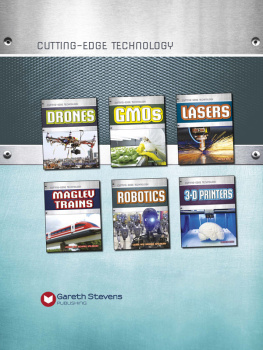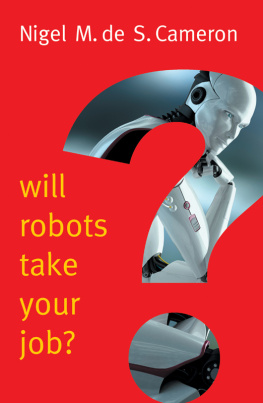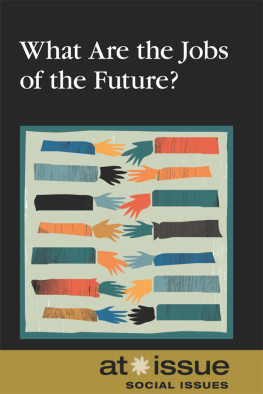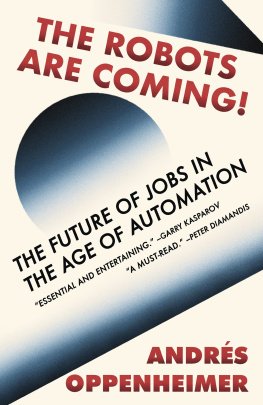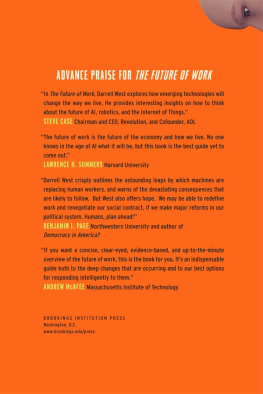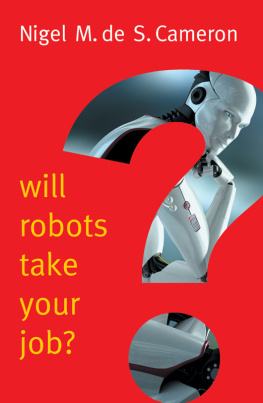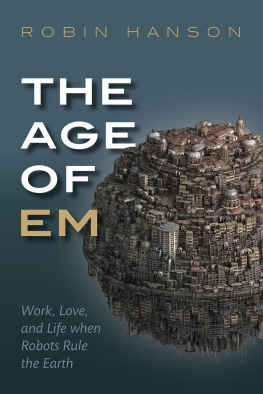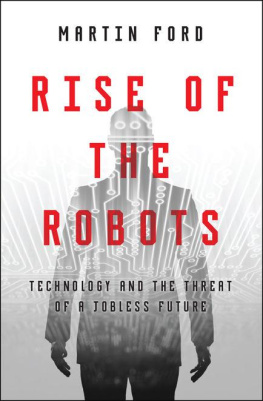Marshall Brain
MANNA
Two Views of Humanitys Future
Depending on how you want to think about it, it was funny or inevitable or symbolic that the robotic takeover did not start at MIT, NASA, Microsoft or Ford. It started at a Burger-G restaurant in Cary, NC on May 17. It seemed like such a simple thing at the time, but May 17 marked a pivotal moment in human history.
Burger-G was a fast food chain that had come out of nowhere starting with its first restaurant in Cary. The Burger-G chain had an attitude and a style that said hip and fun to a wide swath of the American middle class. The chain was able to grow with surprising speed based on its popularity and the public persona of the young founder, Joe Garcia. Over time, Burger-G grew to 1,000 outlets in the U.S. and showed no signs of slowing down. If the trend continued, Burger-G would soon be one of the Top 5 fast food restaurants in the U.S.
The robot installed at this first Burger-G restaurant looked nothing like the robots of popular culture. It was not hominid like C-3PO or futuristic like R2-D2 or industrial like an assembly line robot. Instead it was simply a PC sitting in the back corner of the restaurant running a piece of software. The software was called Manna, version 1.0.
Mannas job was to manage the store, and it did this in a most interesting way. Think about a normal fast food restaurant. A group of employees worked at the store, typically 50 people in a normal restaurant, and they rotated in and out on a weekly schedule. The people did everything from making the burgers to taking the orders to cleaning the tables and taking out the trash. All of these employees reported to the store manager and a couple of assistant managers. The managers hired the employees, scheduled them and told them what to do each day. This was a completely normal arrangement. In the early twenty-first century, there were millions of businesses that operated in this way.
But the fast food industry had a problem, and Burger-G was no different. The problem was the quality of the fast food experience. Some restaurants were run perfectly. They had courteous and thoughtful crew members, clean restrooms, great customer service and high accuracy on the orders. Other restaurants were chaotic and uncomfortable to customers. Since one bad experience could turn a customer off to an entire chain of restaurants, these poorly-managed stores were the Achilles heel of any chain.
To solve the problem, Burger-G contracted with a software consultant and commissioned a piece of software. The goal of the software was to replace the managers and tell the employees what to do in a more controllable way. Manna version 1.0 was born.
Manna was connected to the cash registers, so it knew how many people were flowing through the restaurant. The software could therefore predict with uncanny accuracy when the trash cans would fill up, the toilets would get dirty and the tables needed wiping down. The software was attached to the time clock, so it knew who was working in the restaurant. Manna also had help buttons throughout the restaurant. Small signs on the buttons told customers to push them if they needed help or saw a problem. There was a button in the restroom that a customer could press if the restroom had a problem. There was a button on each trashcan. There was a button near each cash register, one in the kiddie area and so on. These buttons let customers give Manna a heads up when something went wrong.
At any given moment Manna had a list of things that it needed to do. There were orders coming in from the cash registers, so Manna directed employees to prepare those meals. There were also toilets to be scrubbed on a regular basis, floors to mop, tables to wipe, sidewalks to sweep, things to defrost, inventory to rotate, windows to wash and so on. Manna kept track of the hundreds of tasks that needed to get done, and assigned each task to an employee one at a time.
Manna told employees what to do simply by talking to them. Employees each put on a headset when they punched in. Manna had a voice synthesizer, and with its synthesized voice Manna told everyone exactly what to do through their headsets. Constantly. Manna micro-managed minimum wage employees to create perfect performance.
The software would speak to the employees individually and tell each one exactly what to do. For example, Bob, we need to load more patties. Please walk toward the freezer.
Or, Jane, when you are through with this customer, please close your register. Then we will clean the womens restroom.
And so on. The employees were told exactly what to do, and they did it quite happily. It was a major relief actually, because the software told them precisely what to do step by step.
For example, when Jane entered the restroom, Manna used a simple position tracking system built into her headset to know that she had arrived. Manna then told her the first step.
Manna: Place the wet floor warning cone outside the door please.
When Jane completed the task, she would speak the word OK into her headset and Manna moved to the next step in the restroom cleaning procedure.
Manna: Please block the door open with the door stop.
Jane: OK.
Manna: Please retrieve the bucket and mop from the supply closet.
Jane: OK.
And so on.
Once the restroom was clean, Manna would direct Jane to put everything away. Manna would make sure that she carefully washed her hands. Then Manna would immediately start Jane working on a new task. Meanwhile, Manna might send Lisa to the restroom to inspect it and make sure that Jane had done a thorough job. Manna would ask Lisa to check the toilets, the floor, the sink and the mirrors. If Jane missed anything, Lisa would report it.
I grew up in Cary, NC. That was a long time ago, but when I was a kid I lived right in the middle of Cary with my parents. My father was a pilot for a big airline. My mother was a stay-at-home mom and I had a younger sister. We lived in a typical four bedroom suburban home in a nice neighborhood with a swimming pool in the backyard. I was a 15 year-old teenager working at the Burger-G on May 17 when the first Manna system came online.
I can remember putting on the headset for the first time and the computer talking to me and telling me what to do. It was creepy at first, but that feeling really only lasted a day or so. Then you were used to it, and the job really did get easier. Manna never pushed you around, never yelled at you. The girls liked it because Manna didnt hit on them either. Manna simply asked you to do something, you did it, you said, OK, and Manna asked you to do the next step. Each step was easy. You could go through the whole day on autopilot, and Manna made sure that you were constantly doing something. At the end of the shift Manna always said the same thing. You are done for today. Thank you for your help. Then you took off your headset and put it back on the rack to recharge. The first few minutes off the headset were always disorienting there had been this voice in your head telling you exactly what to do in minute detail for six or eight hours. You had to turn your brain back on to get out of the restaurant.
To me, Manna was OK. The job at Burger-G was mindless, and Manna made it easy by telling you exactly what to do. You could even get Manna to play music through your headphones, in the background. Manna had a set of stations that you could choose from. That was a bonus. And Manna kept you busy the entire day. Every single minute, you had something that Manna was telling you to do. If you simply turned off your brain and went with the flow of Manna, the day went by very fast.
My father, on the other hand, did not like Manna at all from the very first day he saw me wearing the headset in the restaurant. He and Mom had come in for lunch and to say hi. I knew they were coming, so I had timed my break so I could sit down with them for a few minutes. When I sat down, my father noticed the headset.






